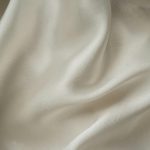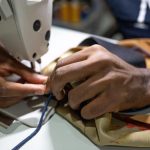You rely on aramid Kevlar fabric when you need strength, lightness, and durability all at once. It’s made from tightly packed, rod-like polymer chains linked by strong bonds, giving it exceptional tensile strength and resistance to heat, abrasion, and chemicals. Its unique weaving boosts flexibility while protecting you from impacts and cuts. Kevlar is essential in personal armor and aerospace applications. Keep exploring to discover how its advanced manufacturing and innovations enhance its performance further.
Table of Contents
Key Takeaways
- Kevlar is a synthetic aramid polymer with rigid, rod-like molecular chains that provide exceptional tensile strength and durability.
- Its unique weaving process tightly interlocks fibers, enhancing strength, flexibility, and energy absorption in protective applications.
- Kevlar fabric is lightweight yet highly resistant to impact, cuts, abrasion, and thermal degradation.
- Manufacturing involves polymer synthesis, fiber spinning, and weaving to produce strong, ordered fibers with superior mechanical properties.
- Kevlar’s applications include ballistic armor, gloves, and aerospace components due to its strength-to-weight ratio and environmental resistance.
What Is Aramid Kevlar Fabric?
Aramid Kevlar fabric is a high-strength material known for its exceptional durability and resistance to heat and impact.
Aramid Kevlar fabric combines high strength with outstanding durability and resistance to heat and impact.
When you use Kevlar, you’re working with a fabric designed to offer superior protection without sacrificing flexibility. It’s lightweight yet incredibly tough, making it ideal for applications where strength and safety are critical.
You’ll find Kevlar in bulletproof vests, protective gloves, and even aerospace components because it withstands extreme conditions while maintaining its integrity.
This fabric’s unique weaving process provides you with enhanced tensile strength, allowing it to absorb and disperse energy effectively.
If you need a reliable material that won’t easily tear or degrade under stress, Kevlar is an excellent choice, offering you both resilience and long-lasting performance.
Chemical Composition and Molecular Structure
The strength of Kevlar comes from its unique chemical composition and molecular structure. You’ll find that Kevlar is a synthetic polymer classified as an aramid, meaning it contains aromatic polyamide chains.
These chains consist of repeating units with benzene rings linked by amide bonds, creating a rigid, rod-like molecular structure. Because of this rigidity, the molecules align closely and form strong hydrogen bonds between chains, enhancing the material’s tensile strength.
When you look at Kevlar’s molecular arrangement, you see tightly packed, highly ordered fibers that resist stretching and breaking. This precise structure is key to Kevlar’s exceptional durability and toughness, allowing it to outperform many other materials in strength-to-weight ratio without adding bulk or weight.
Key Properties of Kevlar Fabric
Understanding Kevlar’s molecular structure helps explain why its fabric exhibits such remarkable properties.
When you handle Kevlar fabric, you’ll notice its exceptional strength and lightweight nature, making it ideal for protective gear. You’ll appreciate its high tensile strength, which means it resists breaking under tension far better than many other fibers.
Additionally, Kevlar offers excellent thermal stability, so it can withstand high temperatures without degrading. You’ll also find it resistant to chemical damage and abrasion, meaning it stays durable even in harsh environments.
Kevlar’s thermal stability and resistance to chemicals and abrasion ensure durability in tough conditions.
Plus, its low elongation guarantees it maintains shape and integrity under stress. When you choose Kevlar fabric, you’re relying on a material that combines toughness, durability, and heat resistance, all essential for demanding applications.
Manufacturing Process of Kevlar
To make Kevlar, you start with polymer synthesis techniques that create its strong molecular chains.
Then, you move on to spinning those polymers into fibers before weaving them into the familiar fabric.
Understanding these steps helps you appreciate how Kevlar gains its remarkable strength and flexibility.
Polymer Synthesis Techniques
Although you mightn’t see it, Kevlar’s remarkable strength starts with a precise chemical process called polymer synthesis. This process creates long, strong molecular chains that give Kevlar its unique properties.
You begin by combining specific monomers, like para-phenylenediamine and terephthaloyl chloride, under carefully controlled conditions. The reaction forms poly-paraphenylene terephthalamide, the polymer behind Kevlar’s durability.
Key steps in polymer synthesis include:
- Maintaining low temperatures to control reaction speed
- Using solvents like sulfuric acid for chain alignment
- Carefully controlling monomer ratios for consistent polymer length
- Removing byproducts to prevent contamination
- Applying stirring techniques to guarantee uniform polymerization
Spinning and Weaving
Once the polymer chains are synthesized, the next essential step transforms them into usable fibers through spinning and weaving.
You begin by dissolving the Kevlar polymer in a solvent to create a viscous liquid, which you then extrude through tiny spinnerets. This process aligns the polymer molecules, giving the fibers their remarkable strength and durability.
After spinning, you wash and stretch the fibers to further enhance their mechanical properties.
Next, you weave these fibers into fabric using specialized looms. The weaving process interlocks the fibers in a tight, consistent pattern, ensuring the fabric maintains Kevlar’s exceptional tensile strength and flexibility.
Comparison With Other High-Strength Fibers
When you compare aramid Kevlar fabric with other high-strength fibers like carbon fiber or ultra-high-molecular-weight polyethylene (UHMWPE), you’ll notice distinct differences in strength, flexibility, and weight.
Kevlar offers excellent tensile strength and impact resistance but is more flexible than carbon fiber. UHMWPE is lighter but less heat-resistant. Here’s what stands out:
Kevlar combines strong impact resistance with flexibility, while UHMWPE is lighter but has lower heat resistance.
- Kevlar resists heat up to around 450°C, while UHMWPE melts at lower temperatures.
- Carbon fiber excels in stiffness but can be brittle under impact.
- UHMWPE provides superior abrasion resistance and low density.
- Kevlar maintains performance under dynamic loads better than carbon fiber.
- Carbon fiber composites often have higher compressive strength than Kevlar.
Understanding these contrasts helps you choose the right fiber for your specific strength and durability needs.
Applications in Personal Protective Equipment
When you wear Kevlar in personal protective gear, you get excellent ballistic resistance that can save your life.
It also offers strong cut and abrasion protection without sacrificing comfort or flexibility.
This combination makes Kevlar ideal for gear that keeps you safe while allowing you to move freely.
Ballistic Resistance Benefits
Although many materials offer some level of protection, Aramid Kevlar fabric stands out for its exceptional ballistic resistance, making it a top choice in personal protective equipment (PPE).
When you rely on Kevlar, you get lightweight yet incredibly strong armor that absorbs and disperses impact energy effectively. This means you can stay protected without sacrificing mobility or comfort.
Kevlar’s tightly woven fibers resist penetration from bullets and shrapnel, reducing injury risk considerably. Here’s why it works so well for ballistic protection:
- High tensile strength fibers stop projectiles quickly
- Energy dispersion minimizes blunt force trauma
- Durable under extreme environmental conditions
- Maintains flexibility for wearer comfort
- Compatible with multi-layered armor systems
You’ll find Kevlar essential for reliable, life-saving ballistic PPE.
Cut and Abrasion Protection
Beyond ballistic resistance, Aramid Kevlar fabric also excels at providing cut and abrasion protection, making it a versatile material in personal protective equipment.
When you wear gear made with Kevlar, you greatly reduce the risk of injuries from sharp objects and rough surfaces. Its tightly woven fibers resist slicing and scraping, so knives, glass shards, or metal edges have a hard time penetrating the fabric.
This durability means you can rely on Kevlar for gloves, sleeves, and jackets that shield you during hazardous tasks. Plus, it maintains its integrity even after repeated contact with abrasive materials, ensuring long-lasting protection.
If you work in construction, manufacturing, or emergency services, Kevlar’s cut and abrasion resistance keeps you safer on the job.
Comfort and Flexibility
Since you need protective gear that doesn’t hold you back, Aramid Kevlar fabric offers impressive comfort and flexibility without sacrificing safety.
You’ll find it adapts well to your movements, making it ideal for personal protective equipment (PPE) like gloves, jackets, and helmets. Kevlar’s lightweight nature reduces fatigue during extended use.
Plus, it resists heat and chemicals, keeping you comfortable in tough environments. Here’s why Kevlar enhances your PPE experience:
- High tensile strength with minimal bulk
- Excellent breathability compared to other protective fabrics
- Retains flexibility even after repeated bending
- Lightweight, reducing overall gear weight
- Resistant to moisture and chemicals, maintaining comfort
This balance of protection and wearability lets you stay agile and safe on the job.
Use of Kevlar in Aerospace and Automotive Industries
When you look at the aerospace and automotive industries, Kevlar plays an essential role in enhancing safety and performance.
You’ll find it in aircraft components like fuselage panels and interior parts, where its lightweight strength helps reduce overall weight without compromising structural integrity.
In vehicles, Kevlar reinforces tires, brake pads, and body panels, improving durability and impact resistance.
You also benefit from Kevlar’s ability to absorb energy during collisions, which adds a critical layer of protection for occupants.
Manufacturers choose Kevlar because it enables them to build lighter, stronger, and safer products that meet rigorous industry standards.
Environmental Resistance and Durability
Although you mightn’t always see it, Kevlar fabric stands up remarkably well to harsh environmental conditions.
When you rely on Kevlar for protection or structural use, you benefit from its exceptional resistance to factors that typically degrade other materials.
Kevlar resists:
- UV radiation, preventing weakening from sun exposure
- Chemical corrosion, allowing use in harsh chemical environments
- Moisture and water absorption, maintaining strength even when wet
- Temperature extremes, functioning reliably from cold to heat
- Abrasion and wear, ensuring long-lasting durability in tough conditions
Innovations and Advances in Kevlar Technology
As you explore the latest developments in Kevlar technology, you’ll find that researchers and manufacturers have pushed the boundaries to enhance its performance and applications.
Innovations like nano-engineered Kevlar fibers have improved tensile strength and flexibility, allowing you to use Kevlar in more demanding environments.
Nano-engineered Kevlar fibers boost tensile strength and flexibility for tougher, more versatile applications.
You’ll also notice advancements in weave patterns and hybrid composites, combining Kevlar with other high-performance materials to boost impact resistance and reduce weight.
Additionally, new manufacturing techniques have made Kevlar fabrics more uniform and consistent, improving reliability.
These advances open doors for you in aerospace, automotive safety, and body armor industries, where enhanced protection and lighter gear are essential.
Care and Maintenance of Kevlar Products
To keep your Kevlar products in top shape, you’ll want to follow proper cleaning techniques that avoid harsh chemicals.
Store them in a cool, dry place to prevent damage from moisture or sunlight.
Also, handle your Kevlar gear carefully to avoid cuts or abrasion that can weaken the fibers.
Cleaning Techniques
When you care for Kevlar products, proper cleaning techniques play an essential role in preserving their strength and durability.
Kevlar’s unique fibers can degrade if exposed to harsh chemicals or improper washing methods. To keep your Kevlar items in top shape, follow these tips:
- Use mild detergent and avoid bleach or fabric softeners.
- Hand wash or use a gentle cycle with cold water.
- Rinse thoroughly to remove all soap residues.
- Air dry away from direct sunlight or heat sources.
- Avoid wringing or twisting to prevent fiber damage.
Storage Recommendations
Proper cleaning sets the foundation for maintaining your Kevlar products, but how you store them also greatly affects their longevity.
Keep your Kevlar items in a cool, dry place away from direct sunlight to prevent UV degradation. Avoid damp environments, as moisture can weaken fibers over time.
Store them flat or gently folded to prevent creases or stress points that might compromise fabric integrity. Use breathable storage bags or containers rather than sealed plastic, allowing air circulation and reducing the risk of mildew.
Keep Kevlar away from harsh chemicals or solvents during storage, as residues may cause damage.
Following these storage tips will help preserve your Kevlar fabric’s strength and performance, ensuring it remains reliable for years to come.
Damage Prevention
Although Kevlar is known for its durability, you still need to handle it with care to avoid damage that can reduce its effectiveness.
To keep your Kevlar products in top shape, follow these essential damage prevention tips. Avoid exposing Kevlar to sharp objects or abrasive surfaces that can cause fraying or cuts. Keep it away from strong chemicals and solvents, which can weaken the fibers.
Don’t expose Kevlar to excessive heat or direct sunlight for long periods to prevent degradation. When cleaning, use mild soap and cold water instead of harsh detergents.
Finally, inspect your Kevlar items regularly for signs of wear or damage to address issues early.
- Avoid sharp and abrasive contact
- Keep away from harsh chemicals
- Limit heat and UV exposure
- Use gentle cleaning methods
- Conduct routine inspections
Frequently Asked Questions
Can Kevlar Fabric Be Recycled or Repurposed?
Like a phoenix rising, you can recycle Kevlar fabric, though it’s tricky. You’ll repurpose it in composites or protective gear, giving new life to this tough material instead of letting it fade into waste.
How Does Kevlar Affect Skin Sensitivity or Allergies?
Kevlar itself rarely causes skin sensitivity or allergies, but its fibers can irritate if they break or shed. If you’re sensitive, wearing protective layers helps prevent itching or reactions when handling Kevlar fabric.
What Are the Common Myths About Kevlar Fabrics?
You might hear Kevlar is uncomfortable or causes allergies, but that’s mostly a myth. It’s actually lightweight and skin-friendly. Some also wrongly think it’s bulletproof alone, but it needs proper layering and design to stop bullets.
How Is Kevlar Priced Compared to Other Advanced Materials?
Kevlar’s price isn’t a walk in the park—it’s higher than many materials like nylon or polyester. But if you’re seeking superior strength and durability, you’ll find the cost worth every penny.
Are There Any Health Risks in Manufacturing Kevlar?
You should know manufacturing Kevlar involves handling chemicals that can irritate your skin and lungs. Proper ventilation and protective gear are essential to minimize risks and keep you safe during the production process.
- Tetron Fabric for Marine Applications: Durability and Use Cases - June 18, 2025
- Tetron Fabric for Outdoor Furniture: Weather Resistance and Care - June 18, 2025
- Tetron Fabric for Wall Coverings: Style and Application Tips - June 18, 2025







